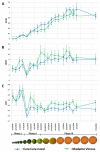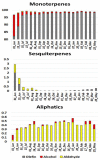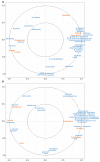Investigations of the Chemical Composition and Aromatic Properties of Peel Essential Oils throughout the Complete Phase of Fruit Development for Two Cultivars of Sweet Orange (Citrus sinensis (L.) Osb.)
- PMID: 36297771
- PMCID: PMC9610080
- DOI: 10.3390/plants11202747
Investigations of the Chemical Composition and Aromatic Properties of Peel Essential Oils throughout the Complete Phase of Fruit Development for Two Cultivars of Sweet Orange (Citrus sinensis (L.) Osb.)
Abstract
The peel essential oil (PEO) of sweet orange is used for flavoring liquors or foods and in the perfumery and cosmetics industry. The fruit maturity stage can modify the essential oil composition and aromatic properties, but little information is available on the evolution of PEO during the entire time set of fruit development. In this study, the yield, chemical composition and aromatic profile over the three phases of orange development were monitored. Four fruit traits (peel color, weight, acidity and sweetness) were recorded to characterize fruit development. Fruits of two sweet orange cultivars were sampled every two weeks from June to May of the next year. PEO was obtained by hydrodistillation and analyzed by gas chromatography coupled with a flame ionization detector (GC-FID). Compounds were identified with GC coupled with mass spectrometry (GC/MS). Ten expert panelists using the descriptor intensity method described the aromatic profile of PEO samples. The PEO composition was richer in oxygenated compounds at early fruit development stages, with an aromatic profile presenting greener notes. During fruit growth (Phases I and II), limonene's proportion increased considerably as a few aliphatic aldehydes brought the characteristic of orange aroma. During fruit maturation (from November to March), the PEO composition and aromatic profile were relatively stable. Later, some modifications were observed. Regardless of the fruit development stage, the two sweet oranges presented distinct PEO compositions and aromatic profiles. These results constitute a temporal reference for the chemical and aromatic evolution of sweet orange PEO in the fruit development process under Mediterranean conditions. During the first two phases of fruit development, many changes occur in the PEO composition and aroma, suggesting that their exploitation could create new products.
Keywords: GC-FID; GC/MS; fruit growth; fruit maturity; oxygenated compounds; sensorial analysis.
Conflict of interest statement
The authors declare no conflict of interest.
Figures







References
-
- Kaur H., Singh G. Recent trends in citrus (citrus spp.) peel utilization: A review. Plant Arch. 2021;21:88–97. doi: 10.51470/PLANTARCHIVES.2021.v21.no1.012. - DOI
-
- Dugo G., Di Giacomo A., editors. Citrus: The Genus Citrus. Taylor & Francis; New York, NY, USA: 2002. Medicinal and aromatic plants industrial profiles.
-
- Gaffney B., Havekotte M., Jacobs B., Costa L. CharmAnalysis of two citrus sinensis peel oil volatiles; Proceedings of the International Citrus Symposium; Orlando, FL, USA. 30 January 1996.
Grants and funding
LinkOut - more resources
Full Text Sources
Miscellaneous

